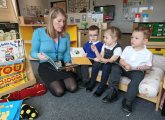Master the art of child-led early years displays and you can enhance your setting and children’s learning in one fell swoop, says Kirstine Beeley…
Reasons for displaying in early years are many and varied, and will reflect quite openly on the overall ethos of your setting.
Do you display purely to make the building look good or do you actively display not just the products of the children’s imaginative learning but the processes too?
Looking at an expanse of blank display space can sometimes prove daunting – as can a lack of available space.
However, with a little bit of thought your display areas, whatever their extent, can become a valuable, interactive part of the learning process.
The EYFS highlights the need for child-centred, child-led learning and emphasises the importance of enabling your environment to enhance and support the learning process.
The Children’s Act 2004 encourages us to empower children and to involve them in decision-making processes. What better way to deliver both than through our displays?
That early learning environments should be places where children are active participants, not passive observers, is a fact we find easy to accept when planning for individual learning activities. Yet we still insist on creating displays that are largely adult-led from beginning to end.
How often have you asked children to work on templates for an adult-inspired wall display, working together to paint individual characters for a larger scene, or even mindlessly gluing together pre-cut pieces to produce near identical creations for a themed offering?
Once you accept that display is not just a means of ‘making the setting look good for parents (or Ofsted)’ the reasons for displays fall largely into two camps.
There are those that showcase children’s creations, and those that you use to support and build on children’s ongoing learning.
As well as discussing each type individually it’s important to look at how we approach display generally when delivering child-centred learning and its impact on the way we set up our early years settings.
We can and should involve children in the display process from beginning to end – from planning, creation, mounting and framing to post-display interaction.
Involve them in all of these processes and they will not only build a heightened sense of pride in their surroundings but will be far more likely to continue interacting with the display once you’ve created it too.
Even if you have an idea for a display in your setting, involving children in the planning and making process will mean that the amount of discussion and learning will far outweigh the need for a pristine, polished result.
The end product may not reflect your original vision. However, the children’s input will have made it so much more special and ensure its creators continually appreciated it.
As well as involving children in the planning and making of large-scale themed displays, you should also involve them in the display of their own creations within your setting.
After all, we spend our days encouraging children to try their hardest and to show pride in their achievements and so the time and effort we take in showcasing their finished products should reflect our own pride in their work.
We should also be taking time to work with children whenever possible to frame and annotate their work. We should be encouraging children to create their own written labels, which should take centre stage, with our writing there to merely enhance the effect.
Seeing the pride on a young child’s face when they see their own mark-making used as part of a display is amazing.
When getting children to help with the planning and delivery we must also consider the accessibility of our displays.
Sit on the floor in your setting, with your eyes at child-height, and see if the displays are as exciting as you think they are.
Can the children actually see them? Do they encourage them to physically get involved? Can they reach them? Instead of being up high to ‘stop children pulling bits off’, displays should be positioned to actively encourage children to interact with them.
If moving your adult-height boards is not practical then look for more creative ways of freeing up child-height spaces.
A cupboard normally pushed against a wall will generally have a flat back which, if turned to run out from the wall, can make a great child-height display solution without the need for additional spending.
Other solutions include using magnetic tape to fix pictures to unused radiators or trifold cardboard display boards, which can be propped on the floor and are available cheaply from many educational suppliers.
With the invention of magnetic and blackboard paint the solutions are endless and suitable for all budgets.
Once you have created your low-level display space, the challenge to make displays truly interactive continues.
Using lift-up flaps, turning wheels and junk box shelves allows children to look and touch the elements of display you’re using.
Remember that children learn using all five of their senses, so wherever possible include the use of multisensory elements such as sounds, smells and feely bags/trays.
The inclusion of photographs and annotated comments encourage children to revisit and discuss the learning process which led to the display in the first place.
It’s important to ensure that displays are revisited with adult input too, as they’re a valuable resource for you to develop discussion and reflection.
Next up, read Kirstine’s article on creating interactive displays.
Kirstine Beeley is an independent trainer, author and consultant, with experience of teaching in early years, primary and SEN settings.

Keep SLC on top of the agenda
Editors picks
